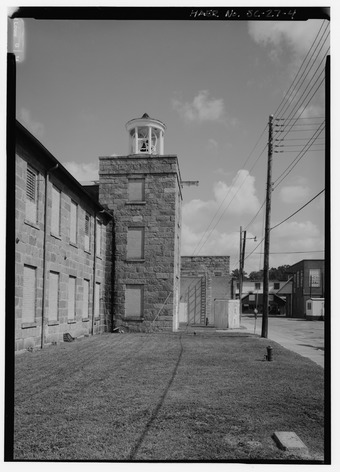Graniteville Historic District (South Carolina) facts for kids
|
Graniteville Historic District
|
|

View of the old mill tower
|
|
| Location | SC 191 and Gregg St., Graniteville, South Carolina |
|---|---|
| Area | 55 acres (22 ha) |
| Built | 1846 |
| Built by | William Gregg |
| Architect | J.B. White |
| Architectural style | Carpenter Gothic |
| NRHP reference No. | 78002491 |
Quick facts for kids Significant dates |
|
| Added to NRHP | June 2, 1978 |
| Designated NHLD | June 2, 1978 |
The Graniteville Historic District is a special place in South Carolina. It was one of the very first towns built in the Southern United States specifically for a textile company. A textile company makes cloth and fabric.
This town was built in the late 1840s by a man named William Gregg. It was near Aiken, South Carolina, and is now known as Graniteville. Gregg designed it to be like the mill towns he saw in New England.
William Gregg used the success of this town to encourage other people in the South to build more factories. This helped the South become a major player in the American textile industry. The Graniteville Historic District includes the original canal, the mill building, homes for the workers, and an old church. It was named a National Historic Landmark District in 1978.
Contents
Graniteville: A Pioneer Mill Town
The Graniteville Historic District shows us how early industrial towns were built in the South. It's a great example of how one person's ideas can change a whole region.
The Vision of William Gregg
William Gregg (1800-1867) was a successful jeweler before he got involved in making textiles. In the 1840s, he visited New England and saw many textile mills and industrial towns. He realized that the Southern states needed to build their own factories to compete with the North.
Gregg got money from people in Charleston to start his own textile business. He wanted to create a model factory town. At the time, it was unusual for the South, which relied on slavery, but Gregg planned to hire white workers.
Building the Graniteville Community
Between 1845 and 1849, William Gregg oversaw the building of Graniteville. He built a mile-long power canal to bring water from Horse Creek and Bridge Creek. This water power would run the mill.
He also built the main mill building, a schoolhouse, and 100 homes for the workers. These homes were made of wood and built in the Carpenter Gothic style. Today, 26 of these original homes are still in good condition.
Gregg also set aside land for churches. Two churches were eventually built, and one of them, St. John's Methodist Church, is still standing today.
The Mill's Operation and Impact
The Graniteville mill was equipped with the newest machines for spinning thread and weaving cloth. It started working in 1849. The mill was very successful, which encouraged others to build similar factories across the South.
The American Civil War slowed down new development. However, the Graniteville mill was very important for making textiles for the Confederacy during the war. Gregg's businesses are still operating today as Graniteville Specialty Fabrics.
What You Can See Today
Graniteville is located west of Aiken, on the east side of Horse Creek. Horse Creek flows into the Savannah River. The historic district includes several important original features.
You can see the original 1846 power canal. It's no longer used for power, but it runs north from the center of Graniteville along Canal Street (South Carolina Highway 191). The original 1849 mill building is also there. You can also find the 1847 Graniteville Academy building, St. John's Methodist Church, and many of the old worker houses on Gregg Street.



